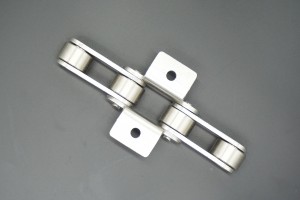Roller chains are commonly used in a variety of industrial applications, including conveying, power transmission, and even lifting. However, when using roller chains for lifting applications, there are several important factors to consider to ensure safety and efficiency.
First, it is crucial to understand the design and construction of roller chains. A roller chain consists of a series of interconnected links, each with a set of inner and outer plates, pins, bushings and rollers. The rollers are designed to mesh with the teeth of the sprocket, allowing the chain to efficiently transfer motion and power. The design is ideal for applications involving the transmission of rotary motion and power, such as conveyor systems and power transmission units.
When it comes to lifting applications, the use of roller chains requires careful consideration. While roller chains are capable of lifting loads, it is critical to ensure that the chain is specifically designed and rated for lifting purposes. Not all roller chains are suitable for lifting, and using the wrong type of chain can lead to safety hazards and equipment failure.
One of the key considerations when using roller chains for lifting is the load capacity of the chain. Lifting applications often involve static or dynamic loads, and the chain selected for the task must be able to safely support the expected load. Always consult the chain manufacturer’s specifications and guidelines to determine the maximum allowable load on the chain. Exceeding the rated capacity of a chain can result in catastrophic failure, posing significant risks to personnel and equipment.
In addition to load capacity, the design and construction of the chain itself plays a vital role in its suitability for lifting applications. Chains used for lifting purposes often have specific design elements such as thicker plates, hardened components and precision manufacturing to ensure strength and durability. These chains are engineered to withstand the stresses and forces associated with lifting heavy objects, making them a safer and more reliable choice for lifting applications.
Additionally, choosing the right sprocket is crucial when lifting with a roller chain. Sprockets play a vital role in the operation of your chain, and using the correct type of sprocket is essential to maintaining smooth and efficient motion. In lifting applications, sprockets must be carefully matched to the chain to ensure proper meshing and minimize the risk of slipping or jamming.
Proper lubrication and maintenance are also important aspects of lifting with roller chains. Adequate lubrication helps reduce friction and wear, extending the life of the chain and ensuring smooth operation. Regular inspection and maintenance procedures should be implemented to detect any signs of wear, fatigue or damage so that the chain can be promptly replaced or repaired to prevent potential failures during lifting operations.
It is worth noting that while roller chains can be used for lifting, there are alternative lifting mechanisms designed specifically for this type of application. For example, cranes, winches, and lifting slings are commonly used to lift heavy objects in industrial and construction environments. Designed and rated specifically for lifting tasks, these lifting equipment offer specific safety features and functionality that may not be found in standard roller chains.
In summary, while roller chains are versatile components widely used in industrial environments, using them in lifting applications requires careful consideration of factors such as load capacity, chain design, sprocket selection, lubrication and maintenance. If properly selected, installed and maintained, roller chains can indeed be used safely and efficiently for lifting. However, it is vital to adhere to manufacturer guidelines and industry best practices to ensure safe and reliable use of roller chains in lifting operations.
Post time: May-15-2024

